The old Schwarzenburg - Fribourg road is recorded in 1385 as the "Fryburgstrass". Today, the pilgrim's path leads from Schwarzenburg railway station along the main road in the direction of Bern. At the end of the village, the path branches off to the left and leads through open terrain via the hamlet of Wart down to the Torenbach stream in the direction of the Sensegraben.
The name Wart goes back to a Roman watchtower.
In the forest we walk along one of the most historically interesting paths: a path carved out of the rock with beautiful paving. On a rocky outcrop we can still see the old foot holes that were used by carters in the past to avoid the narrow passage. A little further down we reach the "Torenöli", where an oil mill once stood. Soon after, we cross the Torenbach for the second time and now reach the Sensegraben. To the right, down the Sense, on a steep rocky outcrop, you can see the old Grasburg fortress.
Bridge over the river Sense
After crossing the Sense, the path leads uphill to Heitenried. Shortly before, we come across a wayside shrine with St. James.
A mistake - and what has become of it
Four scallops, beautifully made of ceramic and set in a concrete base, but facing the wrong way, mean: "Pilgrim, go home...". How can the mistake be rectified?
In search of a solution with bricklayer Fritz Riesen and priest Thomas Sackmann from Heitenried, the priest conjures a statue of St. James out of his "pilgrim's backpack" as if by magic. He wants to give the artistic sculpture, which he brought from Linz in Austria, to the pilgrims.
And so the project is realised: thanks to the "Friends of the Way of St. James", who contributed half of the costs, and thanks to the local craftsmen who volunteered to build a pleasant, solid home for the saint to protect him.
(from Ultreia 38, Magazine of the Friends of the Way of St. James - abridged GE)
The neo-Gothic Michaelskirche in Heitenried, which is not directly on the Jakobsweg (Way of St. James), dates back to 1905. A church already existed here in the 8th/9th century.
There is also a pilgrim's stamp (and a WC).
St James statue in the church
At the south-western end of the village there is a gentle descent, followed by a sunken path lined with hedges and bushes, still called "Stadtgassa" by the elderly. This original path to Fribourg leads on the opposite side of the mountain through a small wood and up again to the chapel of Winterlingen, dedicated to Saint Apollonia. On the following elevated path we reach the village of St. Antoni via the hamlets of Schleif and Cheer.
At the western end of the village we first reach the Reformed and then the Catholic church from 1894, whose patron gave the village its name.
Saint Anthony the Hermit was born around the middle of the 3rd century in central Egypt.
After the early death of his parents he renounced the inherited riches and began a hermit life in the desert. In later years he gathered an association of hermits around him, and when his fatherly leader died in 356, he was very old.
From his grave in the desert, his remains were brought to France via a diversion around 1070 to the church of a small village in the Dauphine countryside, which soon afterwards was named Sainte-Antoine. Just as in early Christianity the graves of the martyrs were visited for prayer, so soon many people seeking help came to the grave of the monk father Anthony, who had already enjoyed great veneration at an early age.
After the founding of a lay brotherhood named after Anthony to supply pilgrims around 1065 in Saint-Antoine, which developed over the next two centuries into the Antonite Order of Canons Regular, his veneration took off in the West. The order's sign T - probably a stylised crutch - became its symbol. When a plague-like disease raged in France in the 12th century, which was called the "holy fire" because it caused terrible pain and hellish burning and made the limbs fall off, Antonius relics proved effective against the same and the disease was called "Antonius fire".
The pigs with which he is depicted stand for his temptations. In fact, the symbol of the pigs is based on the fact that later on, the Antonite order preferred to keep pigs - but as God's creatures, they were allowed to run free, hence the expression "as bold as an Antonian pig".
The historic route descends behind St. Anthony's Church, through sunken paths carved into sandstone to Wissenbach. In the narrow passages we can see recessed slits, which probably served to barricade the path in the past. In Wissenbach there was once a saw and a mill, the traces of which are still visible today.
We continue our way down the stream and reach the Wissenbach Sebastian Chapel on the cantonal road. We cross the busy road, then follow the Taverna stream upwards towards Tafers.
St. James chapel in Tafers.
Chapel of St. James in tafers with the representation of the gallows and chicken miracle. I have come across this legend again and again on the St. James' Way.
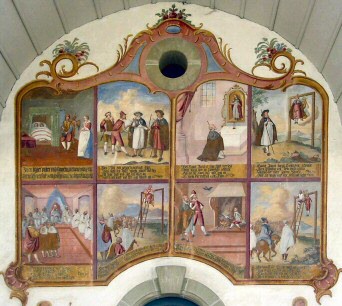
More about the gollows- and chicken miracle
and
explanations to the
Altar of St James in the chapel of St James, Tafers.
From Tafers we hike via Lamprat to Menziswil. Here we pass a chapel of the Virgin Mary, picturesquely situated under trees on the hillside, which was built at the end of the 18th century. Then we meet a beautiful avenue to the west, dominated by ash and oak trees, which leads us along the Hinterbruch manor house.
Shortly before Freiburg we reach the village of Uebewil, situated on the hill.
The Chapel of St. Bartolomew on the Schönberg, at a busy crossroads, is the actual starting point of our pilgrimage through the city of Fribourg. From here, signposts in the form of a stylised scallop on a blue background indicate the route used by the pilgrims. We reach the medieval Red Tower via St. Barthélémy Street and Joseph Chaley Street. It is part of the protective walls of the city of Fribourg built from 1250 onwards. The Cat Tower, which was built around 1360 on a site where the walls were difficult to defend, stands somewhat offset.
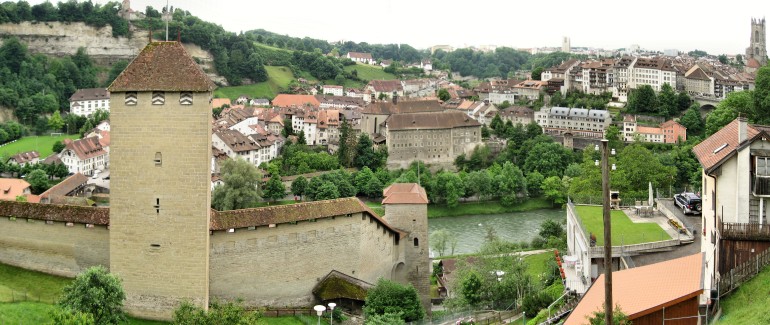
Fribourg and its city walls
We follow the path down the steps of the city wall. It ends at the Bern gate tower, built between 1270 and 1290. These three towers are represented in the coat of arms of the city of Fribourg.
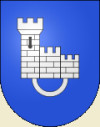
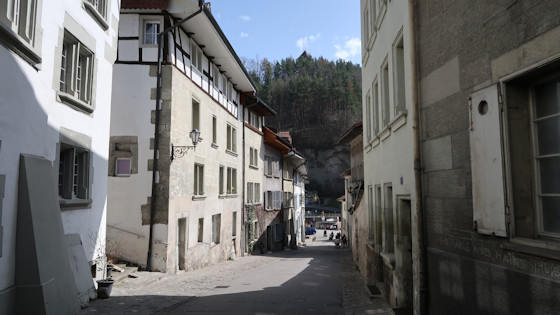
After the Berntor it goes down Schmidgasse (Rue des Forgerons)
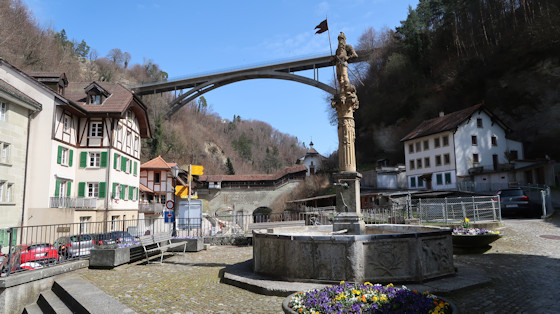
At the bottom of Balmgasse stands this fountain figure, a bearded, armoured banner lord with a dog at his feet as a symbol of loyalty and vigilance on the fountain of fidelity (first version from 1404 - present by Hans Gieng 1552 - 1553).
On the other side of the square is the Gasthof "zum Engel" (to the angel), which once accommodated pilgrims who wanted to spend a comfortable night in the city of Freiburg. This inn, protected by the archangel Raphael, is located in the immediate vicinity of the Bernbrücke, the obligatory passage for all pilgrims and travellers coming from the east.


